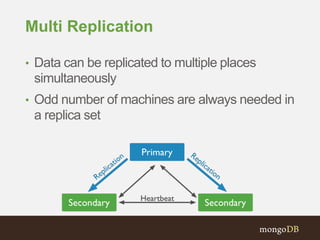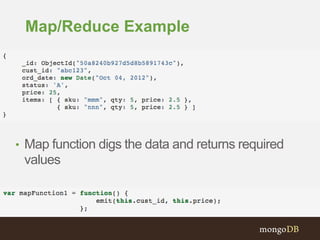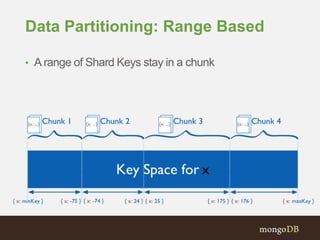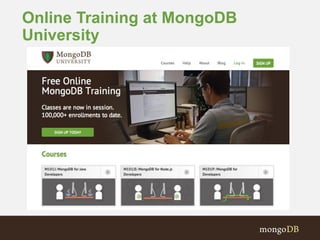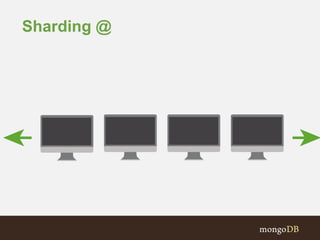MongoDB Basics
- 2. Let’s Know Each Other • Why are you attending? • Do you code? • OS? • Programing Language? • JSON? • MongoDB?
- 3. Agenda • SQL and NoSQL Database • What is MongoDB? • Hands-On and Assignment • Design Models • MongoDB Language Driver • Disaster Recovery • Handling BigData
- 4. Data Patterns & Storage Needs • Product Information • User Information • Purchase Information • Product Reviews • Site Interactions • Social Graph • Search Index
- 5. SQL to NoSQL Design Paradigm Shift
- 7. SQL Storage • Was designed when – Storage and data transfer was costly – Processing was slow – Applications were oriented more towards data collection • Initial adopters were financial institutions
- 8. SQL Storage • Structured – schema • Relational – foreign keys, constraints • Transactional – Atomicity, Consistency, Isolation, Durability • High Availability through robustness – Minimize failures • Optimized for Writes • Typically Scale Up
- 9. NoSQL Storage • Is designed when – Storage is cheap – Data transfer is fast – Much more processing power is available • Clustering of machines is also possible – Applications are oriented towards consumption of User Generated Content – Better on-screen user experience is in demand
- 10. NoSQL Storage • Semi-structured – Schemaless • Consistency,Availability, Partition Tolerance • High Availability through clustering – expect failures • Optimized for Reads • Typically Scale Out
- 11. Different Databases Half Level Deep
- 12. SQL: RDBMS • MySql, Postgresql, Oracle etc. • Stores data in tables having columns – Basic (number, text) data types • Strong query language • Transparent values – Query language can read and filter on them – Relationship between tables based on values • Suited for user info and transactions
- 13. NoSQL Data Model
- 14. NoSQL: Key/Value
- 15. NoSQL: Document • MongoDB, CouchDB etc. • Object Oriented data models – Stores data in document objects having fields – Basic and compound (list, dict) data types • SQL like queries • Transparent values – Can be part of query • Suited for product info and its reviews
- 16. NoSQL: Document
- 17. NoSQL: Column Family • Cassandra, Big Table etc. • Stores data in columns • Transparent values – Can be part of query • SQL like queries • Suited for search
- 18. NoSQL: Graph • Neo4j • Stores data in form of nodes and relationships • Query is in form of traversal • In-memory • Suited for social graph
- 19. NoSQL: Graph
- 20. What is MongoDB?
- 21. MongoDB is a ___________ database 1. Document 2. Open source 3. High performance 4. Horizontally scalable 5. Full featured
- 22. 1. Document Database • Not for .PDF & .DOC files • Adocument is essentially an associative array • Document = JSON object • Document = PHPArray • Document = Python Dict • Document = Ruby Hash • etc
- 24. 2. Open Source • MongoDB is an open source project • On GitHub • Licensed under theAGPL • Started & sponsored by MongoDB Inc (formerly known as 10gen) • Commercial licenses available • Contributions welcome
- 25. 7,000,000+ MongoDB Downloads 150,000+ Online Education Registrants 35,000+ MongoDB Management Service (MMS) Users 30,000+ MongoDB User Group Members 20,000+ MongoDB DaysAttendees Global Community
- 26. 3. High Performance • Written in C++ • Extensive use of memory-mapped files i.e. read-through write-through memory caching. • Runs nearly everywhere • Data serialized as BSON (fast parsing) • Full support for primary & secondary indexes • Document model = less work
- 28. 4. Scalability Auto-Sharding • Increase capacity as you go • Commodity and cloud architectures • Improved operational simplicity and cost visibility
- 29. High Availability • Automated replication and failover • Multi-data center support • Improved operational simplicity (e.g., HW swaps) • Data durability and consistency
- 31. 5. Full Featured • Ad Hoc queries • Real time aggregation • Rich query capabilities • Strongly consistent • Geospatial features • Support for most programming languages • Flexible schema
- 32. MongoDB is Fully Featured
- 34. Terminology
- 35. Do More With Your Data MongoDB Rich Queries • Find Paul’s cars • Find everybody in London with a car built between 1970 and 1980 Geospatial • Find all of the car owners within 5km of Trafalgar Sq. Text Search • Find all the cars described as having leather seats Aggregation • Calculate the average value of Paul’s car collection Map Reduce • What is the ownership pattern of colors by geography over time? (is purple trending up in China?) { first_name: ‘Paul’, surname: ‘Miller’, city: ‘London’, location: [45.123,47.232], cars: [ { model: ‘Bentley’, year: 1973, value: 100000, … }, { model: ‘Rolls Royce’, year: 1965, value: 330000, … } } }
- 38. $ tar –zxvf mongodb-osx-x86_64-2.6.0.tgz $ cd mongodb-osx-i386-2.6.0/bin $ mkdir –p /data/db $ ./mongod Running MongoDB
- 39. MongoDB: Core Binaries • mongod – Database server • mongo – Database client shell • mongos – Router for Sharding
- 40. Getting Help • For mongo shell – mongo –help • Shows options available for running the shell • Inside mongo shell – db.help() • Shows commands available on the object
- 41. Database Operations • Database creation • Creating/changing collection • Data insertion • Data read • Data update • Creating indices • Data deletion • Dropping collection
- 42. MacBook-Pro-:~ $ mongo MongoDB shell version: 2.6.0 connecting to: test > db.cms.insert({text: 'Welcome to MongoDB'}) > db.cms.find().pretty() { "_id" : ObjectId("51c34130fbd5d7261b4cdb55"), "text" : "Welcome to MongoDB" } Mongo Shell
- 43. Diagnostic Tools • mongostat • mongoperf • mongosnif • mongotop
- 44. Import Export Tools • For objects – mongodump – mongorestore – bsondump – mongooplog • For data items – mongoimport – mongoexport
- 45. Assignment • Tasks – assignments.txt • Data – students.json
- 46. Questions?
- 48. Design Models
- 49. First step in any application is Determine your entities
- 50. Entities in our Blogging System • Users (post authors) • Article • Comments • Tags, Category • Interactions (views, clicks)
- 51. In a relational base app We would start by doing schema design
- 53. In a MongoDB based app We start building our app and let the schema evolve
- 54. MongoDB ERD
- 55. Seek = 5+ ms Read = really really fast Post Author Comment Disk seeks and data locality
- 56. Post Author Comment Comment Comment Comment Comment Disk seeks and data locality
- 58. Real applications are not built in the shell
- 59. MongoDB has native bindings for over 12 languages
- 60. Drivers & Ecosystem Drivers Support for the most popular languages and frameworks Frameworks Morphia MEAN Stack Java Python Perl Ruby
- 62. # Python dictionary (or object) >>> article = { ‘title’ : ‘Schema design in MongoDB’, ‘author’ : ‘sarangs’, ‘section’ : ‘schema’, ‘slug’ : ‘schema-design-in-mongodb’, ‘text’ : ‘Data in MongoDB has a flexible schema. So, 2 documents needn’t have same structure. It allows implicit schema to evolve.’, ‘date’ : datetime.utcnow(), ‘tags’ : [‘MongoDB’, ‘schema’] } >>> db[‘articles’].insert(article) Design schema.. In application code
- 63. >>> img_data = Binary(open(‘article_img.jpg’).read()) >>> article = { ‘title’ : ‘Schema evolutionin MongoDB’, ‘author’ : ‘mattbates’, ‘section’ : ‘schema’, ‘slug’ : ‘schema-evolution-in-mongodb’, ‘text’ : ‘MongoDb has dynamic schema. For good performance, you would need an implicit structure and indexes’, ‘date’ : datetime.utcnow(), ‘tags’ : [‘MongoDB’, ‘schema’, ‘migration’], ‘headline_img’ : { ‘img’ : img_data, ‘caption’ : ‘A sample document at the shell’ }} Let’s add a headline image
- 64. >>> article = { ‘title’ : ‘Favourite web application framework’, ‘author’ : ‘sarangs’, ‘section’ : ‘web-dev’, ‘slug’ : ‘web-app-frameworks’, ‘gallery’ : [ { ‘img_url’ : ‘http://x.com/45rty’, ‘caption’ : ‘Flask’, ..}, .. ] ‘date’ : datetime.utcnow(), ‘tags’ : [‘Python’, ‘web’], } >>> db[‘articles’].insert(article) And different types of article
- 65. >>> user = { 'user' : 'sarangs', 'email' : ‘[email protected]', 'password' : ‘sarang', 'joined' : datetime.utcnow(), 'location' : { 'city' : 'Mumbai' }, } } >>> db[‘users’].insert(user) Users and profiles
- 66. Modelling comments (1) • Two collections – articles and comments • Use a reference (i.e. foreign key) to link together • But.. N+1 queries to retrieve article and comments { ‘_id’: ObjectId(..), ‘title’: ‘Schema design in MongoDB’, ‘author’: ‘mattbates’, ‘date’: ISODate(..), ‘tags’: [‘MongoDB’, ‘schema’], ‘section’: ‘schema’, ‘slug’: ‘schema-design-in-mongodb’, ‘comments’: [ ObjectId(..),…] } { ‘_id’: ObjectId(..), ‘article_id’: 1, ‘text’: ‘Agreat article, helped me understand schema design’, ‘date’: ISODate(..),, ‘author’: ‘johnsmith’ }
- 67. Modelling comments (2) • Single articles collection – embed comments in article documents • Pros • Single query, document designed for the access pattern • Locality (disk, shard) • Cons • Comments array is unbounded; documents will grow in size (remember 16MB document limit) { ‘_id’: ObjectId(..), ‘title’: ‘Schema design in MongoDB’, ‘author’: ‘mattbates’, ‘date’: ISODate(..), ‘tags’: [‘MongoDB’, ‘schema’], … ‘comments’: [ { ‘text’: ‘Agreat article, helped me understandschema design’, ‘date’: ISODate(..), ‘author’: ‘johnsmith’ }, … ] }
- 68. Modelling comments (3) • Another option: hybrid of (2) and (3), embed top x comments (e.g. by date, popularity) into the article document • Fixed-size (2.4 feature) comments array • All other comments ‘overflow’ into a comments collection (double write) in buckets • Pros – Document size is more fixed – fewer moves – Single query built – Full comment history with rich query/aggregation
- 69. Modelling comments (3) { ‘_id’: ObjectId(..), ‘title’: ‘Schemadesignin MongoDB’, ‘author’: ‘mattbates’, ‘date’: ISODate(..), ‘tags’:[‘MongoDB’, ‘schema’], … ‘comments_count’: 45, ‘comments_pages’: 1 ‘comments’: [ { ‘text’: ‘Agreat article, helped me understandschema design’, ‘date’: ISODate(..), ‘author’: ‘johnsmith’ }, … ] } Total number of comments • Integer counter updated by update operation as comments added/removed Number of pages • Page is a bucket of 100 comments (see next slide..) Fixed-size comments array • 10 most recent • Sorted by date on insertion
- 70. Modelling comments (3) { ‘_id’: ObjectId(..), ‘article_id’: ObjectId(..), ‘page’: 1, ‘count’: 42 ‘comments’: [ { ‘text’: ‘Agreat article, helped me understand schema design’, ‘date’: ISODate(..), ‘author’: ‘johnsmith’ }, … } One comment bucket (page) document containing up to about 100 comments Array of 100 comment sub- documents
- 71. Modelling interactions • Interactions – Article views – Comments – (Social media sharing) • Requirements – Time series – Pre-aggregated in preparation for analytics
- 72. Modelling interactions • Document per article per day – ‘bucketing’ • Daily counter and hourly sub- document counters for interactions • Bounded array (24 hours) • Single query to retrieve daily article interactions; ready-made for graphing and further aggregation { ‘_id’: ObjectId(..), ‘article_id’: ObjectId(..), ‘section’: ‘schema’, ‘date’: ISODate(..), ‘daily’: { ‘views’: 45, ‘comments’: 150 } ‘hours’: { 0 : { ‘views’: 10 }, 1 : { ‘views’: 2 }, … 23 : { ‘comments’: 14, ‘views’: 10 } } }
- 73. JSON and RESTful API Client-side JSON (eg AngularJS, (BSON) Real applications are not built at a shell – let’s build a RESTful API. Pymongo driver Python web app HTTP(S) REST Examples to follow: Python RESTful API using Flask microframework
- 74. myCMS REST endpoints Method URI Action GET /articles Retrieve all articles GET /articles-by-tag/[tag] Retrieve all articles by tag GET /articles/[article_id] Retrieve a specific article by article_id POST /articles Add a new article GET /articles/[article_id]/comments Retrieve all article comments by article_id POST /articles/[article_id]/comments Add a new comment to an article. POST /users Register a user user GET /users/[username] Retrieve user’s profile PUT /users/[username] Update a user’s profile
- 75. $ git clone http://www.github.com/mattbates/mycms_mongodb $ cd mycms-mongodb $ virtualenv venv $ source venv/bin/activate $ pip install –r requirements.txt $ mkdir –p data/db $ mongod --dbpath=data/db --fork --logpath=mongod.log $ python web.py [$ deactivate] Getting started with the skeleton code
- 76. @app.route('/cms/api/v1.0/articles', methods=['GET']) def get_articles(): """Retrieves all articles in the collection sorted by date """ # query all articles and return a cursor sorted by date cur = db['articles'].find().sort('date’) if not cur: abort(400) # iterate the cursor and add docs to a dict articles = [article for article in cur] return jsonify({'articles' : json.dumps(articles, default=json_util.default)}) RESTful API methods in Python + Flask
- 77. @app.route('/cms/api/v1.0/articles/<string:article_id>/comments', methods = ['POST']) def add_comment(article_id): """Adds a comment to the specified article and a bucket, as well as updating a view counter "”” … page_id = article['last_comment_id'] // 100 … # push the comment to the latest bucket and $inc the count page = db['comments'].find_and_modify( { 'article_id' : ObjectId(article_id), 'page' : page_id}, { '$inc' : { 'count' : 1 }, '$push' : { 'comments' : comment } }, fields= {'count' : 1}, upsert=True, new=True) RESTful API methods in Python + Flask
- 78. # $inc the page count if bucket size (100) is exceeded if page['count'] > 100: db.articles.update( { '_id' : article_id, 'comments_pages': article['comments_pages'] }, { '$inc': { 'comments_pages': 1 } } ) # let's also add to the article itself # most recent 10 comments only res = db['articles'].update( {'_id' : ObjectId(article_id)}, {'$push' : {'comments' : { '$each' : [comment], '$sort' : {’date' : 1 }, '$slice' : -10}}, '$inc' : {'comment_count' : 1}}) … RESTful API methods in Python + Flask
- 79. def add_interaction(article_id, type): """Record the interaction (view/comment) for the specified article into the daily bucket and update an hourly counter """ ts = datetime.datetime.utcnow() # $inc daily and hourly view counters in day/article stats bucket # note the unacknowledged w=0 write concern for performance db['interactions'].update( { 'article_id' : ObjectId(article_id), 'date' : datetime.datetime(ts.year, ts.month, ts.day)}, { '$inc' : { 'daily.{}’.format(type) : 1, 'hourly.{}.{}'.format(ts.hour, type) : 1 }}, upsert=True, w=0) RESTful API methods in Python + Flask
- 80. $ curl -i http://localhost:5000/cms/api/v1.0/articles HTTP/1.0 200 OK Content-Type: application/json Content-Length: 335 Server: Werkzeug/0.9.4 Python/2.7.5 Date: Thu, 10 Apr 2014 16:00:51 GMT { "articles": "[{"title": "Schema design in MongoDB", "text": "Data in MongoDB has a flexible schema..", "section": "schema", "author": "sarangs", "date": {"$date": 1397145312505}, "_id": {"$oid": "5346bef5f2610c064a36a793"}, "slug": "schema-design-in-mongodb", "tags": ["MongoDB", "schema"]}]"} Testing the API – retrieve articles
- 81. $ curl -H "Content-Type: application/json" -X POST -d '{"text":"An interesting article and a great read."}' http://localhost:5000/cms/api/v1.0/articles/52ed73a30bd031362b3c6bb3/comment s { "comment": "{"date": {"$date": 1391639269724}, "text": "An interesting article and a great read."}” } Testing the API – comment on an article
- 82. Disaster Recovery Introduction to Replica Sets and High Availability
- 83. Disasters • Physical Failure – Hardware – Network • Solution – Replica Sets • Provide redundant storage for High Availability – Real time data synchronization • Automatic failover for zero down time
- 84. Replication
- 85. Multi Replication • Data can be replicated to multiple places simultaneously • Odd number of machines are always needed in a replica set
- 86. Single Replication • If you want to have only one or odd number of secondary, you need to setup an arbiter
- 87. Failover • When primary fails, remaining machines vote for electing new primary
- 88. Handling Big Data Introduction to Map/Reduce and Sharding
- 89. Large Data Sets • Problem 1 – Performance • Queries go slow • Solution – Map/Reduce
- 90. Aggregation
- 91. Map Reduce • A way to divide large query computation into smaller chunks • May run in multiple processes across multiple machines • Think of it as GROUP BY of SQL
- 92. Map/Reduce Example • Map function digs the data and returns required values
- 93. Map/Reduce Example • Reduce function uses the output of Map function and generates aggregated value
- 94. Large Data Sets • Problem 2 – Vertical Scaling of Hardware • Can’t increase machine size beyond a limit • Solution – Sharding
- 95. Sharding • Amethod for storing data across multiple machines • Data is partitioned using Shard Keys
- 96. Data Partitioning: Range Based • Arange of Shard Keys stay in a chunk
- 97. Data Partitioning: Hash Bsed • Ahash function on Shard Keys decides the chunk
- 98. Sharded Cluster
- 99. Optimizing Shards: Splitting • In a shard, when size of a chunk increases, the chunk is divided into two
- 100. Optimizing Shards: Balancing • When number of chunks in a shard increase, a few chunks are migrated to other shard
- 101. Schema iteration New feature in the backlog? Documents have dynamic schema so we just iterate the object schema. >>> user = { ‘username’: ‘matt’, ‘first’ : ‘Matt’, ‘last’ : ‘Bates’, ‘preferences’: { ‘opt_out’: True } } >>> user.save(user)
- 102. docs.mongodb.org
- 103. Online Training at MongoDB University
- 104. For More Information Resource Location MongoDB Downloads mongodb.com/download Free Online Training education.mongodb.com Webinars and Events mongodb.com/events White Papers mongodb.com/white-papers Case Studies mongodb.com/customers Presentations mongodb.com/presentations Documentation docs.mongodb.org Additional Info [email protected] Resource Location
- 105. We've introduced a lot of concepts here
- 106. Schema Design @
- 107. Replication @
- 108. Indexing @
- 109. Sharding @
- 110. Questions?










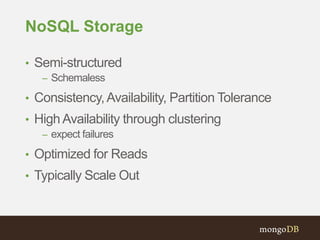
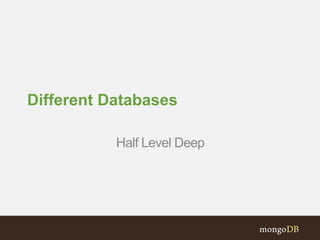


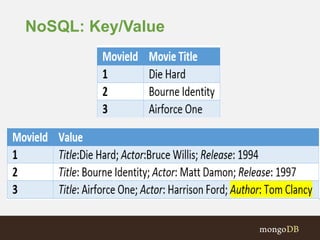


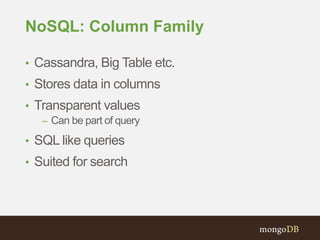

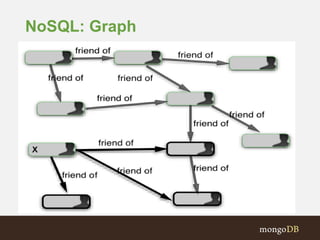
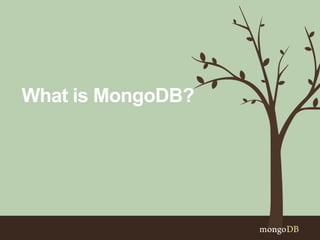
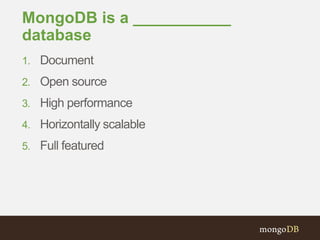

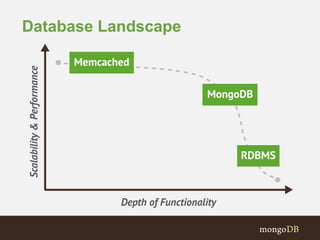
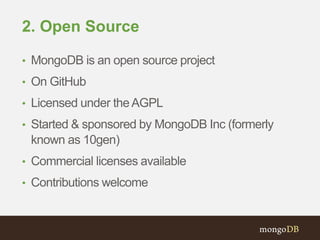










![Do More With Your Data
MongoDB
Rich Queries
• Find Paul’s cars
• Find everybody in London with a car
built between 1970 and 1980
Geospatial
• Find all of the car owners within 5km of
Trafalgar Sq.
Text Search
• Find all the cars described as having
leather seats
Aggregation
• Calculate the average value of Paul’s
car collection
Map Reduce
• What is the ownership pattern of colors
by geography over time? (is purple
trending up in China?)
{
first_name: ‘Paul’,
surname: ‘Miller’,
city: ‘London’,
location: [45.123,47.232],
cars: [
{ model: ‘Bentley’,
year: 1973,
value: 100000, … },
{ model: ‘Rolls Royce’,
year: 1965,
value: 330000, … }
}
}](https://image.slidesharecdn.com/mongodb-140619123704-phpapp02/85/MongoDB-Basics-35-320.jpg)


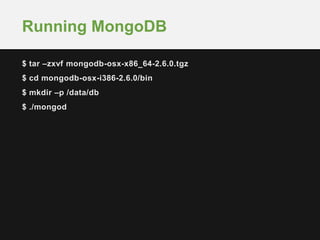
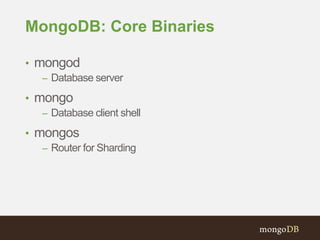
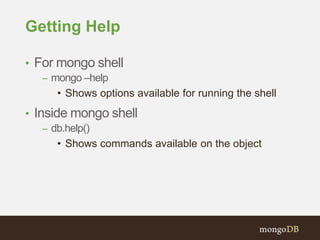

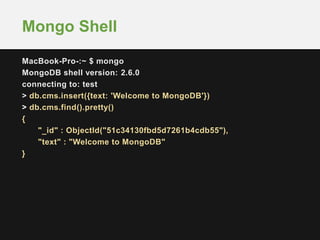










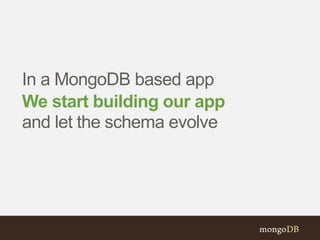





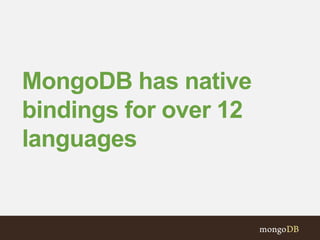


![# Python dictionary (or object)
>>> article = { ‘title’ : ‘Schema design in MongoDB’,
‘author’ : ‘sarangs’,
‘section’ : ‘schema’,
‘slug’ : ‘schema-design-in-mongodb’,
‘text’ : ‘Data in MongoDB has a flexible schema.
So, 2 documents needn’t have same structure.
It allows implicit schema to evolve.’,
‘date’ : datetime.utcnow(),
‘tags’ : [‘MongoDB’, ‘schema’] }
>>> db[‘articles’].insert(article)
Design schema.. In application code](https://image.slidesharecdn.com/mongodb-140619123704-phpapp02/85/MongoDB-Basics-62-320.jpg)
![>>> img_data = Binary(open(‘article_img.jpg’).read())
>>> article = { ‘title’ : ‘Schema evolutionin MongoDB’,
‘author’ : ‘mattbates’,
‘section’ : ‘schema’,
‘slug’ : ‘schema-evolution-in-mongodb’,
‘text’ : ‘MongoDb has dynamic schema. For good
performance, you would need an implicit
structure and indexes’,
‘date’ : datetime.utcnow(),
‘tags’ : [‘MongoDB’, ‘schema’, ‘migration’],
‘headline_img’ : {
‘img’ : img_data,
‘caption’ : ‘A sample document at the shell’
}}
Let’s add a headline image](https://image.slidesharecdn.com/mongodb-140619123704-phpapp02/85/MongoDB-Basics-63-320.jpg)
![>>> article = { ‘title’ : ‘Favourite web application framework’,
‘author’ : ‘sarangs’,
‘section’ : ‘web-dev’,
‘slug’ : ‘web-app-frameworks’,
‘gallery’ : [
{ ‘img_url’ : ‘http://x.com/45rty’, ‘caption’ : ‘Flask’, ..},
..
]
‘date’ : datetime.utcnow(),
‘tags’ : [‘Python’, ‘web’],
}
>>> db[‘articles’].insert(article)
And different types of article](https://image.slidesharecdn.com/mongodb-140619123704-phpapp02/85/MongoDB-Basics-64-320.jpg)
![>>> user = {
'user' : 'sarangs',
'email' : ‘sarang.shravagi@gmail.com',
'password' : ‘sarang',
'joined' : datetime.utcnow(),
'location' : { 'city' : 'Mumbai' },
}
} >>> db[‘users’].insert(user)
Users and profiles](https://image.slidesharecdn.com/mongodb-140619123704-phpapp02/85/MongoDB-Basics-65-320.jpg)
![Modelling comments (1)
• Two collections – articles and comments
• Use a reference (i.e. foreign key) to link together
• But.. N+1 queries to retrieve article and comments
{
‘_id’: ObjectId(..),
‘title’: ‘Schema design in MongoDB’,
‘author’: ‘mattbates’,
‘date’: ISODate(..),
‘tags’: [‘MongoDB’, ‘schema’],
‘section’: ‘schema’,
‘slug’: ‘schema-design-in-mongodb’,
‘comments’: [ ObjectId(..),…]
}
{ ‘_id’: ObjectId(..),
‘article_id’: 1,
‘text’: ‘Agreat article, helped me
understand schema design’,
‘date’: ISODate(..),,
‘author’: ‘johnsmith’
}](https://image.slidesharecdn.com/mongodb-140619123704-phpapp02/85/MongoDB-Basics-66-320.jpg)
![Modelling comments (2)
• Single articles collection –
embed comments in article
documents
• Pros
• Single query, document
designed for the access pattern
• Locality (disk, shard)
• Cons
• Comments array is unbounded;
documents will grow in size
(remember 16MB document
limit)
{
‘_id’: ObjectId(..),
‘title’: ‘Schema design in MongoDB’,
‘author’: ‘mattbates’,
‘date’: ISODate(..),
‘tags’: [‘MongoDB’, ‘schema’],
…
‘comments’: [
{
‘text’: ‘Agreat article,
helped me
understandschema design’,
‘date’: ISODate(..),
‘author’: ‘johnsmith’
},
…
]
}](https://image.slidesharecdn.com/mongodb-140619123704-phpapp02/85/MongoDB-Basics-67-320.jpg)

![Modelling comments (3)
{
‘_id’: ObjectId(..),
‘title’: ‘Schemadesignin MongoDB’,
‘author’: ‘mattbates’,
‘date’: ISODate(..),
‘tags’:[‘MongoDB’, ‘schema’],
…
‘comments_count’: 45,
‘comments_pages’: 1
‘comments’: [
{
‘text’: ‘Agreat article, helped me
understandschema design’,
‘date’: ISODate(..),
‘author’: ‘johnsmith’
},
…
]
}
Total number of comments
• Integer counter updated by
update operation as
comments added/removed
Number of pages
• Page is a bucket of 100
comments (see next slide..)
Fixed-size comments array
• 10 most recent
• Sorted by date on insertion](https://image.slidesharecdn.com/mongodb-140619123704-phpapp02/85/MongoDB-Basics-69-320.jpg)
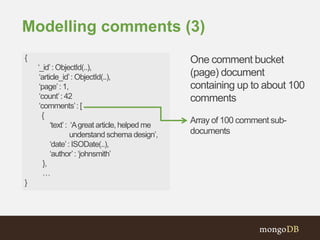

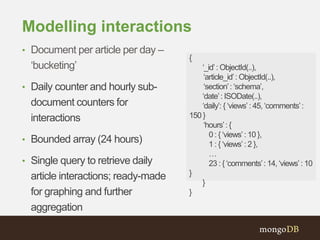

![myCMS REST endpoints
Method URI Action
GET /articles Retrieve all articles
GET /articles-by-tag/[tag] Retrieve all articles by tag
GET /articles/[article_id] Retrieve a specific article by article_id
POST /articles Add a new article
GET /articles/[article_id]/comments Retrieve all article comments by
article_id
POST /articles/[article_id]/comments Add a new comment to an article.
POST /users Register a user user
GET /users/[username] Retrieve user’s profile
PUT /users/[username] Update a user’s profile](https://image.slidesharecdn.com/mongodb-140619123704-phpapp02/85/MongoDB-Basics-74-320.jpg)
![$ git clone http://www.github.com/mattbates/mycms_mongodb
$ cd mycms-mongodb
$ virtualenv venv
$ source venv/bin/activate
$ pip install –r requirements.txt
$ mkdir –p data/db
$ mongod --dbpath=data/db --fork --logpath=mongod.log
$ python web.py
[$ deactivate]
Getting started with the skeleton
code](https://image.slidesharecdn.com/mongodb-140619123704-phpapp02/85/MongoDB-Basics-75-320.jpg)
![@app.route('/cms/api/v1.0/articles', methods=['GET'])
def get_articles():
"""Retrieves all articles in the collection
sorted by date
"""
# query all articles and return a cursor sorted by date
cur = db['articles'].find().sort('date’)
if not cur:
abort(400)
# iterate the cursor and add docs to a dict
articles = [article for article in cur]
return jsonify({'articles' : json.dumps(articles, default=json_util.default)})
RESTful API methods in Python +
Flask](https://image.slidesharecdn.com/mongodb-140619123704-phpapp02/85/MongoDB-Basics-76-320.jpg)
![@app.route('/cms/api/v1.0/articles/<string:article_id>/comments', methods = ['POST'])
def add_comment(article_id):
"""Adds a comment to the specified article and a
bucket, as well as updating a view counter
"””
…
page_id = article['last_comment_id'] // 100
…
# push the comment to the latest bucket and $inc the count
page = db['comments'].find_and_modify(
{ 'article_id' : ObjectId(article_id),
'page' : page_id},
{ '$inc' : { 'count' : 1 },
'$push' : {
'comments' : comment } },
fields= {'count' : 1},
upsert=True,
new=True)
RESTful API methods in Python +
Flask](https://image.slidesharecdn.com/mongodb-140619123704-phpapp02/85/MongoDB-Basics-77-320.jpg)
![# $inc the page count if bucket size (100) is exceeded
if page['count'] > 100:
db.articles.update(
{ '_id' : article_id,
'comments_pages': article['comments_pages'] },
{ '$inc': { 'comments_pages': 1 } } )
# let's also add to the article itself
# most recent 10 comments only
res = db['articles'].update(
{'_id' : ObjectId(article_id)},
{'$push' : {'comments' : { '$each' : [comment],
'$sort' : {’date' : 1 },
'$slice' : -10}},
'$inc' : {'comment_count' : 1}})
…
RESTful API methods in Python +
Flask](https://image.slidesharecdn.com/mongodb-140619123704-phpapp02/85/MongoDB-Basics-78-320.jpg)
![def add_interaction(article_id, type):
"""Record the interaction (view/comment) for the
specified article into the daily bucket and
update an hourly counter
"""
ts = datetime.datetime.utcnow()
# $inc daily and hourly view counters in day/article stats bucket
# note the unacknowledged w=0 write concern for performance
db['interactions'].update(
{ 'article_id' : ObjectId(article_id),
'date' : datetime.datetime(ts.year, ts.month, ts.day)},
{ '$inc' : {
'daily.{}’.format(type) : 1,
'hourly.{}.{}'.format(ts.hour, type) : 1
}},
upsert=True,
w=0)
RESTful API methods in Python +
Flask](https://image.slidesharecdn.com/mongodb-140619123704-phpapp02/85/MongoDB-Basics-79-320.jpg)
![$ curl -i http://localhost:5000/cms/api/v1.0/articles
HTTP/1.0 200 OK
Content-Type: application/json
Content-Length: 335
Server: Werkzeug/0.9.4 Python/2.7.5
Date: Thu, 10 Apr 2014 16:00:51 GMT
{
"articles": "[{"title": "Schema design in MongoDB", "text": "Data in MongoDB
has a flexible schema..", "section": "schema", "author": "sarangs", "date":
{"$date": 1397145312505}, "_id": {"$oid": "5346bef5f2610c064a36a793"},
"slug": "schema-design-in-mongodb", "tags": ["MongoDB", "schema"]}]"}
Testing the API – retrieve articles](https://image.slidesharecdn.com/mongodb-140619123704-phpapp02/85/MongoDB-Basics-80-320.jpg)




